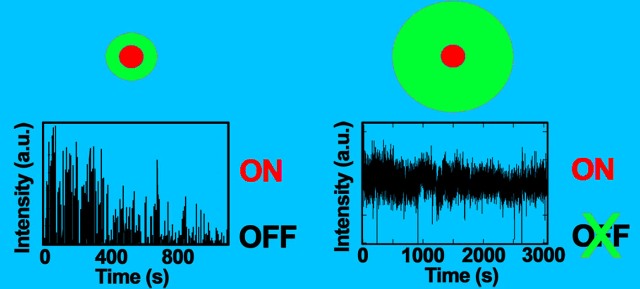Feb 20 2014
Quantum Materials Corporation and Los Alamos National Laboratory's (LANL) today announce Quantum Materials optioning Thick-Shell 'Giant' Quantum Dot patented technology with the potential of 10 to 100-fold improvement in solid-state brightness over conventional nanocrystal quantum dots (QD). High brightness leads to efficient use of materials and increased performance in electronic displays and solid state (LED) lighting.
 Blinking behavior of thin-shell vs. thick-shell nanocrystal quantum dots. On the left side, thin-shell quantum dot shows constant incidences of blinking "Off". On the right side, thick-shell quantum dot shows very rare incidences of blinking. As detected over an interval of 3000ms, as measured by intensity in arbitrary units vs. time. Diagram Courtesy of Los Alamos National Laboratory. (PRNewsFoto/Quantum Materials Corporation)
Blinking behavior of thin-shell vs. thick-shell nanocrystal quantum dots. On the left side, thin-shell quantum dot shows constant incidences of blinking "Off". On the right side, thick-shell quantum dot shows very rare incidences of blinking. As detected over an interval of 3000ms, as measured by intensity in arbitrary units vs. time. Diagram Courtesy of Los Alamos National Laboratory. (PRNewsFoto/Quantum Materials Corporation)
"Blinking" is a tendency of quantum dots to flash off momentarily often noted as a challenge for certain quantum dot applications. LANL scientists also discovered that thick-shelling quantum dots dramatically reduces fluorescence intermittency by better separating absorption by the shell and emission by the core, significantly suppressing blinking (see diagram).
Commercial product lifetimes can be increased in QD-LCD backplane displays, solid state lighting films and projection lighting because the thick-shell technology has demonstrated the ability to extend the service life of quantum dots exposed to higher temperatures and/or high intensity light. Further, non-blinking quantum dots that can produce higher light output with less heat generation will spur new product development and optimized design.
LANL also achieved thick-shell "Giant" QD near-infrared (NIR) emission for a major advance affecting medical imaging applications, optoelectronics, lasers, telecommunication and solar photovoltaics. For example, targeted cancer cells will be easier to identify and track, and varied absorption and emission ranges offer tailored performance in electronics and solar designs.
Quantum Materials plans to integrate the LANL thick-shell technology into its quantum dot product line. The Company's automated process is capable of manufacturing industrial-scale quantities while maintaining tight uniformity and makes possible the reliable, economical production of thick-shell tetrapod quantum dots having the exact characteristics necessary for specific applications.
Stephen B. Squires, Quantum Materials CEO and Founder said, "We believe that the number of quantum dot performance improvements afforded by adding thick-shell technology to our Tetrapod Quantum Dots will set us significantly ahead of our competition. Our ability to manufacture uniform industrial-scale quantities of quantum dots engineered for optimal application-specific performance parameters will expedite acceptance of these new technologies by display and lighting manufacturers."
David Doderer, QMC VP of R&D added, "Combining LANL thick-shelling abilities with QMC's tetrapod quantum dots' properties of high uniformity, and narrow emission (higher color purity) will be revolutionary in affecting quantum dot lifetime, quality of performance, enhancing of stability, and color rendering."
The technology was made available through LANL's new Express Licensing Program. Dr. Jennifer Hollingsworth, of the Center for Integrated Technologies (CINT) at LANL is the Principal Investigator for Thick-Shell Quantum Dots.
About Quantum Materials Corp.
Quantum Materials Corp. manufactures Tetrapod Quantum Dots for use in medical, display, solar energy and lighting applications through an automated production process. Tetrapod Quantum Dot semiconductors enable a new level of engineered performance for consumer and industrial products. QMC's volume manufacturing methods assure economies of scale, reliability and uniformity to drive innovative discovery to commercial success. (http://www.qmcdots.com)
About Los Alamos National Laboratory
Los Alamos National Laboratory (www.lanl.gov) is operated by Los Alamos National Security, LLC, for the U.S. Department of Energy's National Nuclear Security Administration (NNSA) to support NNSA in its mission. Los Alamos develops and applies science and technology to ensure the safety and reliability of the U.S. nuclear deterrent; to reduce the threat of weapons of mass destruction, proliferation and terrorism; and to solve national problems in defense, energy, environment and infrastructure.